Deck 10: Muscular Tissue
Question
Question
Question
Question
Question
Question
Question
Question
Question
Question
Question
Question
Question
Question
Question
Question
Question
Question
Question
Question
Question
Question
Question
Question
Question
Question
Question
Question
Question
Question
Question
Question
Question
Question
Question
Question
Question
Question
Question
Question
Question
Question
Question
Question
Question
Question
Question
Question
Question
Question
Question
Question
Question
Question
Question
Question
Question
Question
Question
Question
Question
Question
Question
Question
Question
Question
Question
Question
Question
Question
Question
Question
Question
Question
Question

Unlock Deck
Sign up to unlock the cards in this deck!
Unlock Deck
Unlock Deck
1/75
Play
Full screen (f)
Deck 10: Muscular Tissue
1
In skeletal muscle, the sarcoplasmic reticulum (SR):
A) forms transverse (T) tubules.
B) is similar to the Golgi complex.
C) contains extracellular fluid.
D) releases Ca2+ to trigger contraction.
A) forms transverse (T) tubules.
B) is similar to the Golgi complex.
C) contains extracellular fluid.
D) releases Ca2+ to trigger contraction.
D
2
The two types of smooth muscle tissue are:
A) visceral (single-unit) and parietal.
B) red and white.
C) visceral (single-unit) and multiunit.
D) radial and circular.
A) visceral (single-unit) and parietal.
B) red and white.
C) visceral (single-unit) and multiunit.
D) radial and circular.
C
3
During an isotonic contraction of a muscle, the muscle shortens while the tension in the muscle increases, as in straightening the legs when rising from a sitting position to a standing position.
False
4
Compared to skeletal muscle, cardiac muscle differs in that it:
A) contracts for shorter periods of time.
B) has a short refractory period.
C) has a different arrangement of thick and thin filaments.
D) has branching cells.
A) contracts for shorter periods of time.
B) has a short refractory period.
C) has a different arrangement of thick and thin filaments.
D) has branching cells.

Unlock Deck
Unlock for access to all 75 flashcards in this deck.
Unlock Deck
k this deck
5
Which of the following is TRUE of myosin? 1. It is located in the A band of the sarcomere.
2) It binds to tropomyosin during contraction.
3) It forms thick filaments.
4) The molecules are helix shaped.
A) 1, 2, 3, 4
B) 1, 2, 3 only
C) 1, 3 only
D) 2, 4 only
2) It binds to tropomyosin during contraction.
3) It forms thick filaments.
4) The molecules are helix shaped.
A) 1, 2, 3, 4
B) 1, 2, 3 only
C) 1, 3 only
D) 2, 4 only

Unlock Deck
Unlock for access to all 75 flashcards in this deck.
Unlock Deck
k this deck
6
The ability of muscular tissue to contract forcefully when stimulated is:
A) elasticity.
B) extensibility.
C) stability.
D) contractility.
A) elasticity.
B) extensibility.
C) stability.
D) contractility.

Unlock Deck
Unlock for access to all 75 flashcards in this deck.
Unlock Deck
k this deck
7
Neurotransmitter receptors are found where on the sarcolemma?
A) transverse (T) tubules
B) motor end plate
C) sarcoplasmic reticulum
D) muscle filaments
A) transverse (T) tubules
B) motor end plate
C) sarcoplasmic reticulum
D) muscle filaments

Unlock Deck
Unlock for access to all 75 flashcards in this deck.
Unlock Deck
k this deck
8
Which is a correct statement?
A) A muscle fiber (cell) contains myofibrils.
B) A myofibril contains thick and thin filaments.
C) Thick and thin filaments are arranged into sarcomeres.
D) All of the choices are correct.
A) A muscle fiber (cell) contains myofibrils.
B) A myofibril contains thick and thin filaments.
C) Thick and thin filaments are arranged into sarcomeres.
D) All of the choices are correct.

Unlock Deck
Unlock for access to all 75 flashcards in this deck.
Unlock Deck
k this deck
9
The protein has direct contact with actin in a muscle in the resting state, while the _____ protein has direct contact with actin in a muscle in the contracting state.
A) tropomyosin; myosin
B) myosin; troponin
C) titin; tropomyosin
D) troponin; myomesin
A) tropomyosin; myosin
B) myosin; troponin
C) titin; tropomyosin
D) troponin; myomesin

Unlock Deck
Unlock for access to all 75 flashcards in this deck.
Unlock Deck
k this deck
10
Place the following events in the correct order. 1. ACh is released into the synaptic cleft.
2) Synaptic vesicles fuse with the plasma membrane.
3) A muscle action potential is triggered.
4) An action potential arrives at the synaptic end bulb.
5) ACh binds to receptors on the motor end plate.
A) 2, 4, 5, 1, 3
B) 4, 3, 1, 2, 5
C) 1, 2, 4, 3, 5
D) 4, 2, 1, 5, 3
2) Synaptic vesicles fuse with the plasma membrane.
3) A muscle action potential is triggered.
4) An action potential arrives at the synaptic end bulb.
5) ACh binds to receptors on the motor end plate.
A) 2, 4, 5, 1, 3
B) 4, 3, 1, 2, 5
C) 1, 2, 4, 3, 5
D) 4, 2, 1, 5, 3

Unlock Deck
Unlock for access to all 75 flashcards in this deck.
Unlock Deck
k this deck
11
A somatic motor neuron is a nerve cell that stimulates a skeletal muscle fiber (cell) to contract.

Unlock Deck
Unlock for access to all 75 flashcards in this deck.
Unlock Deck
k this deck
12
The ability of muscular tissue to be stretched without being damaged is:
A) elasticity.
B) extensibility.
C) excitability.
D) contractility.
A) elasticity.
B) extensibility.
C) excitability.
D) contractility.

Unlock Deck
Unlock for access to all 75 flashcards in this deck.
Unlock Deck
k this deck
13
During contraction in a skeletal muscle fiber:
A) the thick filaments meet at the center of the sarcomere.
B) the sarcomere length does not change.
C) actin and myosin molecules contract, causing filaments to shorten.
D) myosin cross-bridges (heads) move the thin filaments so that their ends meet or overlap in the center of the sarcomere.
A) the thick filaments meet at the center of the sarcomere.
B) the sarcomere length does not change.
C) actin and myosin molecules contract, causing filaments to shorten.
D) myosin cross-bridges (heads) move the thin filaments so that their ends meet or overlap in the center of the sarcomere.

Unlock Deck
Unlock for access to all 75 flashcards in this deck.
Unlock Deck
k this deck
14
A bundle (fascicle) of skeletal muscle fibers (cells) is separated from neighboring bundles by perimysium.

Unlock Deck
Unlock for access to all 75 flashcards in this deck.
Unlock Deck
k this deck
15
One sarcomere contains all of the following EXCEPT:
A) the H zone
B) myosin
C) myofibrils
D) the M line
A) the H zone
B) myosin
C) myofibrils
D) the M line

Unlock Deck
Unlock for access to all 75 flashcards in this deck.
Unlock Deck
k this deck
16
As skeletal muscle ages, after age 30, which of the following does NOT occur?
A) decrease in maximal strength
B) decrease in the relative number of slow oxidative fibers
C) replacement of muscle mass by fibrous connective tissue and adipose tissue
D) slowing of muscle reflexes
A) decrease in maximal strength
B) decrease in the relative number of slow oxidative fibers
C) replacement of muscle mass by fibrous connective tissue and adipose tissue
D) slowing of muscle reflexes

Unlock Deck
Unlock for access to all 75 flashcards in this deck.
Unlock Deck
k this deck
17
The skeletal muscle fibers that fatigue most easily are: 1. red muscle fibers.
2) slow oxidative (type I) fibers.
3) fast glycolytic (type IIb) fibers.
A) 1 only
B) 2 only
C) 3 only
D) both 1 and 3.
2) slow oxidative (type I) fibers.
3) fast glycolytic (type IIb) fibers.
A) 1 only
B) 2 only
C) 3 only
D) both 1 and 3.

Unlock Deck
Unlock for access to all 75 flashcards in this deck.
Unlock Deck
k this deck
18
Which of the following is FALSE regarding skeletal muscle fibers (cells)?
A) Each fiber is a single cell with a hundred or more nuclei.
B) The cells are cylindrical and are arranged in parallel fashion.
C) A skeletal muscle fiber may be up to 30 cm (12 in.) long.
D) The myofibrils are arranged at right angles to the long axis of the cell, creating cross striations.
A) Each fiber is a single cell with a hundred or more nuclei.
B) The cells are cylindrical and are arranged in parallel fashion.
C) A skeletal muscle fiber may be up to 30 cm (12 in.) long.
D) The myofibrils are arranged at right angles to the long axis of the cell, creating cross striations.

Unlock Deck
Unlock for access to all 75 flashcards in this deck.
Unlock Deck
k this deck
19
An increase (hypertrophy) or decrease (atrophy) in muscle size is due to: 1. increased or decreased numbers of muscle cells.
2) increased or decreased deposition of adipose tissue.
3) increased or decreased size of skeletal muscle fibers.
A) 1 only
B) 2 only
C) 3 only
D) both 1 and 3.
2) increased or decreased deposition of adipose tissue.
3) increased or decreased size of skeletal muscle fibers.
A) 1 only
B) 2 only
C) 3 only
D) both 1 and 3.

Unlock Deck
Unlock for access to all 75 flashcards in this deck.
Unlock Deck
k this deck
20
The close association of a transverse (T) tubule and two terminal cisterns forms a:
A) sarcomere
B) triad
C) fasciculus
D) cross-bridge.
A) sarcomere
B) triad
C) fasciculus
D) cross-bridge.

Unlock Deck
Unlock for access to all 75 flashcards in this deck.
Unlock Deck
k this deck
21
The neurotransmitter released at a neuromuscular junction (in skeletal muscle) is dopamine.

Unlock Deck
Unlock for access to all 75 flashcards in this deck.
Unlock Deck
k this deck
22
Cardiac muscle fibers (cells) contain more mitochondria than do skeletal muscle fibers (cells).

Unlock Deck
Unlock for access to all 75 flashcards in this deck.
Unlock Deck
k this deck
23
The specialized region of sarcolemma that is located at a neuromuscular junction is called the synaptic cleft.

Unlock Deck
Unlock for access to all 75 flashcards in this deck.
Unlock Deck
k this deck
24
The transverse (T) tubule is a specialized region of sarcolemma that is located at a neuromuscular junction.

Unlock Deck
Unlock for access to all 75 flashcards in this deck.
Unlock Deck
k this deck
25
Cardiac muscle tissue may be classified as either visceral (single-unit) or multiunit muscle tissue.

Unlock Deck
Unlock for access to all 75 flashcards in this deck.
Unlock Deck
k this deck
26
The contractile elements of skeletal muscle fibers (cells) are myofibrils.

Unlock Deck
Unlock for access to all 75 flashcards in this deck.
Unlock Deck
k this deck
27
To a limited degree in mature skeletal muscle, new skeletal muscle fibers (cells) can arise from satellite cells.

Unlock Deck
Unlock for access to all 75 flashcards in this deck.
Unlock Deck
k this deck
28
A somatic motor neuron together with all the skeletal muscle fibers (cells) it stimulates is called a motor unit.

Unlock Deck
Unlock for access to all 75 flashcards in this deck.
Unlock Deck
k this deck
29
List, categorize, and describe the proteins found in myofibrils.

Unlock Deck
Unlock for access to all 75 flashcards in this deck.
Unlock Deck
k this deck
30
Intercalated discs in cardiac muscle contain what type(s) of cell junctions?
A) desmosomes and gap junctions.
B) tight junctions only
C) gap junctions and tight junctions
D) hemidesmosomes
A) desmosomes and gap junctions.
B) tight junctions only
C) gap junctions and tight junctions
D) hemidesmosomes

Unlock Deck
Unlock for access to all 75 flashcards in this deck.
Unlock Deck
k this deck
31
The connective tissue that surrounds and separates individual skeletal muscle fibers (cells) is called _____.
A) sarcolemma
B) fascia
C) endomysium
D) epimysium
A) sarcolemma
B) fascia
C) endomysium
D) epimysium

Unlock Deck
Unlock for access to all 75 flashcards in this deck.
Unlock Deck
k this deck
32
When examined microscopically, striations are visible in the _____ muscle tissues.
A) cardiac and skeletal
B) smooth and skeletal
C) cardiac and smooth
D) skeletal ONLY
A) cardiac and skeletal
B) smooth and skeletal
C) cardiac and smooth
D) skeletal ONLY

Unlock Deck
Unlock for access to all 75 flashcards in this deck.
Unlock Deck
k this deck
33
The darker area in a sarcomere is called the I band.

Unlock Deck
Unlock for access to all 75 flashcards in this deck.
Unlock Deck
k this deck
34
List four functions of muscle tissue and in one sentence for each function, elaborate on the function or give an example to illustrate the function.

Unlock Deck
Unlock for access to all 75 flashcards in this deck.
Unlock Deck
k this deck
35
Compare the microscopic anatomy and the resistance to fatigue of the three types of skeletal muscle fibers.

Unlock Deck
Unlock for access to all 75 flashcards in this deck.
Unlock Deck
k this deck
36
_____ are large dense irregular connective tissue sheets that wrap around groups of skeletal muscles.
A) Epimysium
B) Perimysium
C) Endomysium
D) Fascia
A) Epimysium
B) Perimysium
C) Endomysium
D) Fascia

Unlock Deck
Unlock for access to all 75 flashcards in this deck.
Unlock Deck
k this deck
37
Describe the four steps of the contraction cycle.

Unlock Deck
Unlock for access to all 75 flashcards in this deck.
Unlock Deck
k this deck
38
A small amount of tautness or tension in a skeletal muscle due to weak, involuntary contractions of its motor units is called _____.
A) muscle tone
B) an eccentric isotonic contraction
C) a concentric isotonic contraction
A) muscle tone
B) an eccentric isotonic contraction
C) a concentric isotonic contraction

Unlock Deck
Unlock for access to all 75 flashcards in this deck.
Unlock Deck
k this deck
39
Epimysium surrounds skeletal muscle fibers (cells) within fascicles.

Unlock Deck
Unlock for access to all 75 flashcards in this deck.
Unlock Deck
k this deck
40
Autorhythmicity is the ability to repeatedly generate spontaneous action potentials.

Unlock Deck
Unlock for access to all 75 flashcards in this deck.
Unlock Deck
k this deck
41
Identify this organelle of the muscle fiber (cell) labeled B. 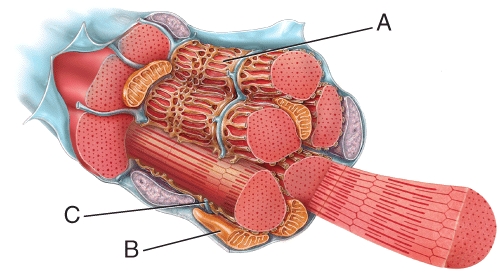
A) myofibril
B) sarcoplasmic reticulum
C) nucleus
D) mitochondrion

A) myofibril
B) sarcoplasmic reticulum
C) nucleus
D) mitochondrion

Unlock Deck
Unlock for access to all 75 flashcards in this deck.
Unlock Deck
k this deck
42
The connective tissue covering this structure labeled B is the 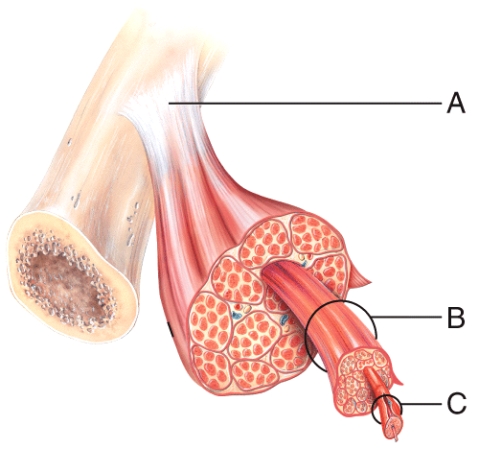
A) sarcolemma
B) endomysium
C) perimysium
D) epimysium

A) sarcolemma
B) endomysium
C) perimysium
D) epimysium

Unlock Deck
Unlock for access to all 75 flashcards in this deck.
Unlock Deck
k this deck
43
The connective tissue covering this structure labeled C is the 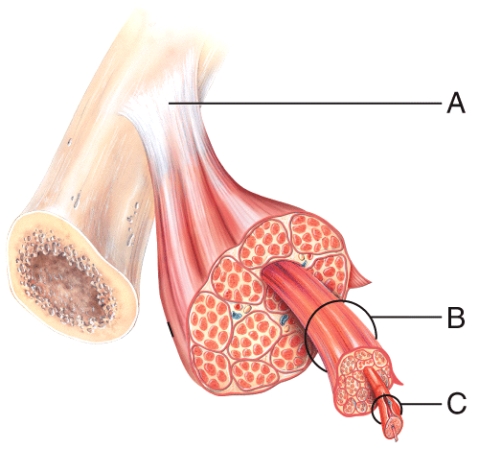
A) sarcolemma
B) endomysium
C) perimysium
D) epimysium

A) sarcolemma
B) endomysium
C) perimysium
D) epimysium

Unlock Deck
Unlock for access to all 75 flashcards in this deck.
Unlock Deck
k this deck
44
_____ muscle fibers (cells) do NOT contain sarcomeres.
A) Smooth
B) Cardiac
C) Skeletal
D) Smooth and cardiac
A) Smooth
B) Cardiac
C) Skeletal
D) Smooth and cardiac

Unlock Deck
Unlock for access to all 75 flashcards in this deck.
Unlock Deck
k this deck
45
Match the connective tissue components of skeletal muscle with the tissues. Identify the description of a motor end plate.
A) region of sarcolemma at the neuromuscular junction
B) portion of axon terminal membrane that releases acetylcholine into the cleft
A) region of sarcolemma at the neuromuscular junction
B) portion of axon terminal membrane that releases acetylcholine into the cleft

Unlock Deck
Unlock for access to all 75 flashcards in this deck.
Unlock Deck
k this deck
46
Match the connective tissue components of skeletal muscle with the tissues. Identify the description that matches fast glycolytic fibers.
A) adapted for intense movements of short duration, such as weight lifting
B) adapted for maintaining posture and endurance-type activities
A) adapted for intense movements of short duration, such as weight lifting
B) adapted for maintaining posture and endurance-type activities

Unlock Deck
Unlock for access to all 75 flashcards in this deck.
Unlock Deck
k this deck
47
Identify features of this muscle fiber (cell) structure labeled C. 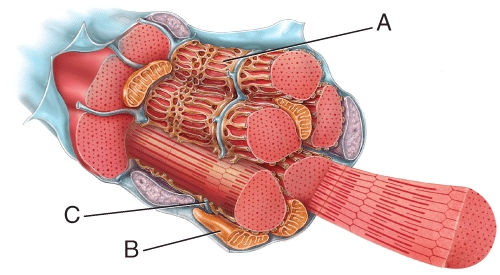
A) invagination of the sarcolemma
B) open to the outside of the cell
C) muscle action potentials are able to propagate through
D) All of the choices are features

A) invagination of the sarcolemma
B) open to the outside of the cell
C) muscle action potentials are able to propagate through
D) All of the choices are features

Unlock Deck
Unlock for access to all 75 flashcards in this deck.
Unlock Deck
k this deck
48
This band labeled A will shorten during muscle contraction. 


Unlock Deck
Unlock for access to all 75 flashcards in this deck.
Unlock Deck
k this deck
49
The structure that is labeled A is referred to as a ligament. 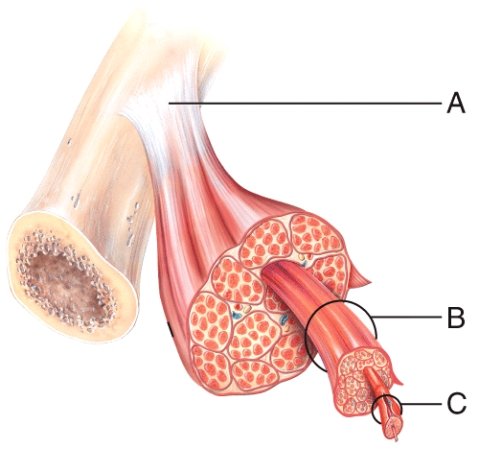


Unlock Deck
Unlock for access to all 75 flashcards in this deck.
Unlock Deck
k this deck
50
The muscle fibers that are oxidative and resistant to fatigue are the slow oxidative fibers.

Unlock Deck
Unlock for access to all 75 flashcards in this deck.
Unlock Deck
k this deck
51
Match the connective tissue components of skeletal muscle with the tissues. Identify the description of a synaptic vesicle.
A) membrane-enclosed sac that stores neurotransmitter
B) a small space that separates the cell membrane of a motor neuron from the sarcolemma of a skeletal muscle cell
A) membrane-enclosed sac that stores neurotransmitter
B) a small space that separates the cell membrane of a motor neuron from the sarcolemma of a skeletal muscle cell

Unlock Deck
Unlock for access to all 75 flashcards in this deck.
Unlock Deck
k this deck
52
Match the connective tissue components of skeletal muscle with the tissues. Identify the description that matches acetylcholine receptors.
A) integral transmembrane proteins of axon membrane; bind with acetylcholine
B) integral transmembrane proteins of motor end plate; bind with acetylcholine
A) integral transmembrane proteins of axon membrane; bind with acetylcholine
B) integral transmembrane proteins of motor end plate; bind with acetylcholine

Unlock Deck
Unlock for access to all 75 flashcards in this deck.
Unlock Deck
k this deck
53
Match the connective tissue components of smooth muscle with the tissues. Identify the characteristics of smooth muscle tissue.
A) voluntary, striated
B) involuntary, nonstriated
A) voluntary, striated
B) involuntary, nonstriated

Unlock Deck
Unlock for access to all 75 flashcards in this deck.
Unlock Deck
k this deck
54
Match the connective tissue components of skeletal muscle with the tissues. Identify the characteristics of skeletal muscle tissue.
A) voluntary, striated
B) involuntary, striated
A) voluntary, striated
B) involuntary, striated

Unlock Deck
Unlock for access to all 75 flashcards in this deck.
Unlock Deck
k this deck
55
Match the connective tissue components of skeletal muscle with the tissues. Match perimysium with the correct tissue type.
A) areolar connective tissue plus adipose tissue
B) dense irregular connective tissue
A) areolar connective tissue plus adipose tissue
B) dense irregular connective tissue

Unlock Deck
Unlock for access to all 75 flashcards in this deck.
Unlock Deck
k this deck
56
Match the connective tissue components of skeletal muscle with the tissues. Identify the description that matches slow oxidative fibers.
A) largest in diameter
B) smallest in diameter
A) largest in diameter
B) smallest in diameter

Unlock Deck
Unlock for access to all 75 flashcards in this deck.
Unlock Deck
k this deck
57
Identify this organelle of the muscle fiber (cell) labeled A. 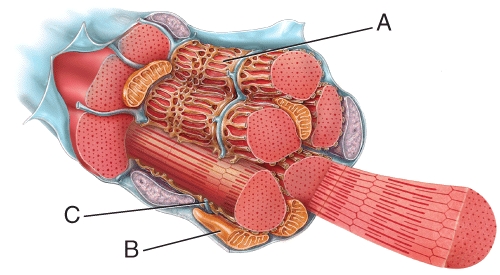
A) Golgi complex
B) sarcoplasmic reticulum
C) nucleus
D) mitochondrion

A) Golgi complex
B) sarcoplasmic reticulum
C) nucleus
D) mitochondrion

Unlock Deck
Unlock for access to all 75 flashcards in this deck.
Unlock Deck
k this deck
58
Match the connective tissue components of skeletal muscle with the tissues. Match endomysium with the correct tissue type.
A) loose connective tissue (mostly reticular fibers)
B) dense connective tissue
A) loose connective tissue (mostly reticular fibers)
B) dense connective tissue

Unlock Deck
Unlock for access to all 75 flashcards in this deck.
Unlock Deck
k this deck
59
Match the connective tissue components of skeletal muscle with the tissues. Match epimysium with the correct tissue type.
A) areolar connective tissue plus adipose tissue
B) dense irregular connective tissue
A) areolar connective tissue plus adipose tissue
B) dense irregular connective tissue

Unlock Deck
Unlock for access to all 75 flashcards in this deck.
Unlock Deck
k this deck
60
Match the connective tissue components of smooth muscle with the tissues. Identify the characteristic of smooth muscle tissue.
A) no transverse tubules
B) no muscle tone
A) no transverse tubules
B) no muscle tone

Unlock Deck
Unlock for access to all 75 flashcards in this deck.
Unlock Deck
k this deck
61
Somites give rise to the skeletal muscles of the thoracic and abdominal walls as well as the appendages.

Unlock Deck
Unlock for access to all 75 flashcards in this deck.
Unlock Deck
k this deck
62
All muscles of the body are derived from ectoderm.

Unlock Deck
Unlock for access to all 75 flashcards in this deck.
Unlock Deck
k this deck
63
Track and field athletes specializing in the 100 meter dash will train their bodies for explosive power when pushing off the starting blocks. Which type of muscle fiber is being isolated during strength training to generate this explosive power?
A) slow oxidative fibers
B) fast oxidative glycolytic fibers
C) fast glycolytic fibers
A) slow oxidative fibers
B) fast oxidative glycolytic fibers
C) fast glycolytic fibers

Unlock Deck
Unlock for access to all 75 flashcards in this deck.
Unlock Deck
k this deck
64
Age associated muscle decline is irreversible.

Unlock Deck
Unlock for access to all 75 flashcards in this deck.
Unlock Deck
k this deck
65
Body building increases the size and strength of which type of muscle fiber?
A) slow oxidative fibers
B) fast oxidative glycolytic fibers
C) fast glycolytic fibers
A) slow oxidative fibers
B) fast oxidative glycolytic fibers
C) fast glycolytic fibers

Unlock Deck
Unlock for access to all 75 flashcards in this deck.
Unlock Deck
k this deck
66
This structure labeled C extends from M-line to M-line. 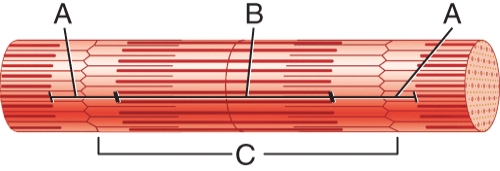


Unlock Deck
Unlock for access to all 75 flashcards in this deck.
Unlock Deck
k this deck
67
Which type of muscle develops from the mesodermal cells that envelope the developing gastrointestinal tract, viscera, and blood vessels?
A) cardiac muscle
B) smooth muscle
C) skeletal muscle
A) cardiac muscle
B) smooth muscle
C) skeletal muscle

Unlock Deck
Unlock for access to all 75 flashcards in this deck.
Unlock Deck
k this deck
68
Strength training has a positive impact on the body by
A) increasing bone strength.
B) raising resting metabolic rate.
C) reducing feelings of stress and fatigue.
D) all of these answers are correct.
A) increasing bone strength.
B) raising resting metabolic rate.
C) reducing feelings of stress and fatigue.
D) all of these answers are correct.

Unlock Deck
Unlock for access to all 75 flashcards in this deck.
Unlock Deck
k this deck
69
The proteins found in the A band of a sarcomere is/are
A) actin and myosin.
B) actin, myosin, titin, troponin, and tropomyosin.
C) myosin and titin.
D) tropomyosin and troponin.
A) actin and myosin.
B) actin, myosin, titin, troponin, and tropomyosin.
C) myosin and titin.
D) tropomyosin and troponin.

Unlock Deck
Unlock for access to all 75 flashcards in this deck.
Unlock Deck
k this deck
70
Stretching before a workout is the best way to increase flexibility of muscles.

Unlock Deck
Unlock for access to all 75 flashcards in this deck.
Unlock Deck
k this deck
71
This band labeled B will shorten during muscle contraction. 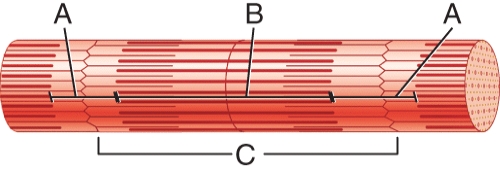


Unlock Deck
Unlock for access to all 75 flashcards in this deck.
Unlock Deck
k this deck
72
For contraction of a muscle to being, what event must occur at the sarcolemma?
A) blockage of reuptake channels
B) exocytosis of vesicles storing neurotransmitters
C) intracellular calcium levels increase after potassium entry
D) acetylcholine binding and opening of sodium channels
A) blockage of reuptake channels
B) exocytosis of vesicles storing neurotransmitters
C) intracellular calcium levels increase after potassium entry
D) acetylcholine binding and opening of sodium channels

Unlock Deck
Unlock for access to all 75 flashcards in this deck.
Unlock Deck
k this deck
73
Cardiac and smooth muscle tissues have autorhythmicity.

Unlock Deck
Unlock for access to all 75 flashcards in this deck.
Unlock Deck
k this deck
74
After years of living a sedentary life, you start a couch-to-13.1K training regimen. This change in activity includes daily long distance runs. These distance runs are inducing changes in which muscle fiber types?
A) slow oxidative fibers into fast oxidative glycolytic fibers
B) fast oxidative glycolytic fibers into fast glycolytic fibers
C) fast glycolytic fibers into fast oxidative glycolytic fibers
D) fast glycolytic fibers into slow oxidative fibers
A) slow oxidative fibers into fast oxidative glycolytic fibers
B) fast oxidative glycolytic fibers into fast glycolytic fibers
C) fast glycolytic fibers into fast oxidative glycolytic fibers
D) fast glycolytic fibers into slow oxidative fibers

Unlock Deck
Unlock for access to all 75 flashcards in this deck.
Unlock Deck
k this deck
75
Which group of muscles usually weaken first impacting the daily activities of individuals over 65?
A) muscles of the abdomen
B) muscles of the lower limb
C) muscles of the thorax
D) muscles of the upper limb
A) muscles of the abdomen
B) muscles of the lower limb
C) muscles of the thorax
D) muscles of the upper limb

Unlock Deck
Unlock for access to all 75 flashcards in this deck.
Unlock Deck
k this deck



